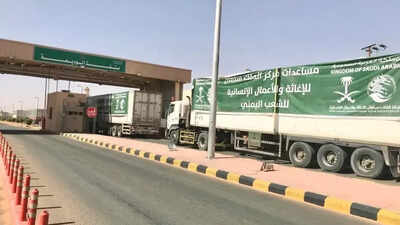The Al-Wade’ah border crossing, situated in Yemen’s Hadhramaut Governorate just 67 kilometers from Saudi Arabia’s Sharurah, is the sole operational land gateway between the two nations. This singular status has transformed the crossing into an indispensable vital artery for millions of travelers and merchants. However, this lifeline exists within a failing Saudi policy framework. Saudi Arabia’s long-standing, security-centric strategy in Yemen has not only failed to defeat the Houthi movement but has also inadvertently destabilized the border, fueling deep local resentment and undermining the very security it seeks to protect.
What is Al-Wadi‘ah and why does it matter?
Al-Wadi‘ah (also spelled Al-Wadea) is a key land border crossing linking Saudi Arabia and Yemen. Located in the Najran province of Saudi Arabia and connecting Yemen’s Hadramawt region, it handles people, vehicles and goods moving between the two countries. Recent reports describe it as “the only open entry point from Yemen into Saudi Arabia since the start of the conflict”. The crossing is vital for several reasons:
- It facilitates pilgrimage flows for example, Yemeni pilgrims use Al-Wadi‘ah to enter Saudi Arabia for Hajj/Umrah.
- It serves as a trade and humanitarian route goods, relief supplies and commercial cargo pass through.
- It is a strategic point for security, border control and regional diplomacy between Riyadh and Sana’a.
A brief historical background
The Saudi Arabia–Yemen border has a long and complex history. The two countries signed the Treaty of Jeddah in June 2000, formalising the border demarcation after decades of ambiguity and dispute. Al-Wadi‘ah itself has been contested in earlier decades. For instance, the so-called Al‑Wadi‘ah War in late 1969 between Saudi Arabia and South Yemen (People’s Democratic Republic of Yemen) centred on the border town of Al-Wadi‘ah and Sharurah. More recently, during Yemen’s civil conflict and Saudi-led military involvement, much of the Saudi–Yemen border was closed orrestricted. Yet Al-Wadi‘ah remained a functioning corridor in many periods, particularly for pilgrims and humanitarian aid.
The current role of Al-Wadi‘ah
Today, Al-Wadi‘ah has upgraded infrastructure: customs clearance is reportedly fully automated, with mounted scanners and online documentation. Pilgrim flows are strongly featured: Saudi authorities recently reported smooth reception of Yemeni pilgrims entering through Al-Wadi‘ah on their way to Hajj/Umrah.However, significant challenges remain. The crossing has witnessed heavy congestion as travellers queue for visas, permits and processing. Reports say waiting times can stretch many hours or more. Security remains a key concern: large drug-smuggling attempts were intercepted at Al-Wadi‘ah, one involving 1.5 million narcotic pills concealed in a cooling truck.
The humanitarian and pilgrimage lifeline
For the average Yemeni, Al-Wadi‘ah is crucial for survival, travel, and religious duty.
- Aid Corridor: The crossing is the principal route for sending humanitarian and relief aid from Saudi Arabia to Yemen. Organizations like the King Salman Humanitarian Aid and Relief Center (KSrelief) regularly dispatch thousands of tons of medical supplies, shelter materials, and food baskets through this point to reach displaced persons’ camps and hospitals across multiple Yemeni governorates.
- Pilgrimage Gateway: It serves as the main overland entry point for Yemeni citizens traveling to Saudi Arabia to perform the Hajj and Umrah rituals. The Saudi government allocates special lanes and dedicated services at the crossing, including health control centers, rest areas, and volunteer services, to facilitate a smooth and comfortable journey for the pilgrims.
- Daily Travel: Thousands of Yemenis rely on this crossing daily for personal travel, family visits, and to seek employment, cementing its role as a key point of contact between the two societies.
How travel works between Saudi Arabia and Yemen?
Travel between Saudi Arabia and Yemen through the Al-Wadi‘ah border crossing remains possible, but it is highly regulated and limited to essential or approved purposes. For Saudi citizens, entering Yemen is not open for regular tourism and requires special authorization. Saudis may only cross for government-approved missions, humanitarian work, business engagements with permits, or family-related visits, and these need prior security clearance from Saudi authorities as well as entry approval from Yemen. Due to safety concerns, Saudi Arabia continues to advise its nationals against non-essential travel to Yemen.For Yemeni citizens, the Al-Wadi‘ah crossing serves as the primary land route into Saudi Arabia. Entry is allowed for those holding valid Saudi visas or residency permits (Iqama), including workers, students, individuals seeking medical treatment, and approved humanitarian cases. Travelers undergo thorough documentation, health, and security checks before being permitted to cross. While movement for Yemeni citizens is active, it is not open for casual or tourism travel.Overall, the border allows controlled movement rather than open travel, with both sides enforcing strict checks due to security conditions. Regular tourism between the two countries remains suspended, and flights continue to be limited to humanitarian or UN-operated routes. Go to Source


